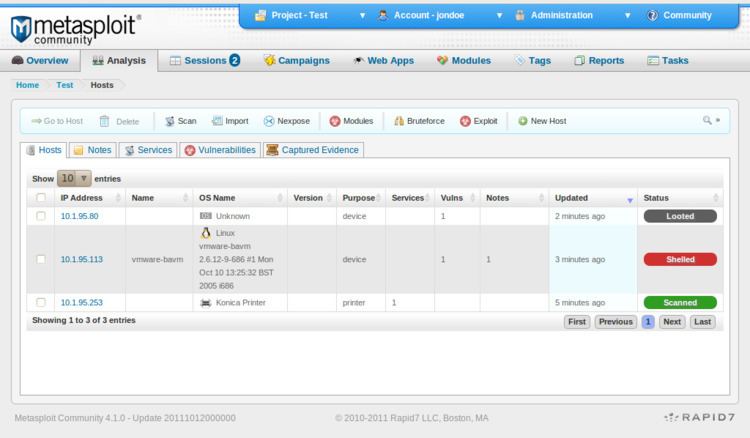Developer(s) Rapid7 LLC Operating system | Development status Active Type Security | |
 | ||
Stable release 4.12 / May 13, 2016 (2016-05-13) | ||
The Metasploit Project is a computer security project that provides information about security vulnerabilities and aids in penetration testing and IDS signature development.
Contents
- History
- Metasploit Framework
- Metasploit interfaces
- Metasploit Framework Edition
- Metasploit Community Edition
- Metasploit Express
- Metasploit Pro
- Armitage
- Cobalt Strike
- Exploits
- Payloads
- Contributors
- References
Its best-known sub-project is the open source Metasploit Framework, a tool for developing and executing exploit code against a remote target machine. Other important sub-projects include the Opcode Database, shellcode archive and related research.
The Metasploit Project is well known for its anti-forensic and evasion tools, some of which are built into the Metasploit Framework.
History
Metasploit was created by H. D. Moore in 2003 as a portable network tool using Perl. By 2007, the Metasploit Framework had been completely rewritten in Ruby. On October 21, 2009, the Metasploit Project announced that it had been acquired by Rapid7, a security company that provides unified vulnerability management solutions.
Like comparable commercial products such as Immunity's Canvas or Core Security Technologies' Core Impact, Metasploit can be used to test the vulnerability of computer systems or to break into remote systems. Like many information security tools, Metasploit can be used for both legitimate and unauthorized activities. Since the acquisition of the Metasploit Framework, Rapid7 has added two open core proprietary editions called Metasploit Express and Metasploit Pro.
Metasploit's emerging position as the de facto exploit development framework led to the release of software vulnerability advisories often accompanied by a third party Metasploit exploit module that highlights the exploitability, risk and remediation of that particular bug. Metasploit 3.0 began to include fuzzing tools, used to discover software vulnerabilities, rather than just exploits for known bugs. This avenue can be seen with the integration of the lorcon wireless (802.11) toolset into Metasploit 3.0 in November 2006. Metasploit 4.0 was released in August 2011.
Metasploit Framework
The basic steps for exploiting a system using the Framework include:
- Choosing and configuring an exploit (code that enters a target system by taking advantage of one of its bugs; about 900 different exploits for Windows, Unix/Linux and Mac OS X systems are included);
- Optionally checking whether the intended target system is susceptible to the chosen exploit;
- Choosing and configuring a payload (code that will be executed on the target system upon successful entry; for instance, a remote shell or a VNC server);
- Choosing the encoding technique so that the intrusion-prevention system (IPS) ignores the encoded payload;
- Executing the exploit.
This modular approach – allowing the combination of any exploit with any payload – is the major advantage of the Framework. It facilitates the tasks of attackers, exploit writers and payload writers.
Metasploit runs on Unix (including Linux and Mac OS X) and on Windows. The Metasploit Framework can be extended to use add-ons in multiple languages.
To choose an exploit and payload, some information about the target system is needed, such as operating system version and installed network services. This information can be gleaned with port scanning and OS fingerprinting tools such as Nmap. Vulnerability scanners such as Nexpose, Nessus, and OpenVAS can detect target system vulnerabilities. Metasploit can import vulnerability scanner data and compare the identified vulnerabilities to existing exploit modules for accurate exploitation.
Metasploit interfaces
There are several interfaces for Metasploit available. The most popular are maintained by Rapid7 and Strategic Cyber LLC.
Metasploit Framework Edition
The free version. It contains a command line interface, third-party import, manual exploitation and manual brute forcing.This free version of metasploit project also includes Zenmap , a well known ports-scanner and a compiler for Ruby , the language in which this version of metasploit was written.
Metasploit Community Edition
In October 2011, Rapid7 released Metasploit Community Edition, a free, web-based user interface for Metasploit. Metasploit Community is based on the commercial functionality of the paid-for editions with a reduced set of features, including network discovery, module browsing and manual exploitation. Metasploit Community is included in the main installer.
Metasploit Express
In April 2010, Rapid7 released Metasploit Express, an open-core commercial edition for security teams who need to verify vulnerabilities. It offers a graphical user interface, integrates nmap for discovery, and adds smart bruteforcing as well as automated evidence collection.
Metasploit Pro
In October 2010, Rapid7 added Metasploit Pro, an open-core commercial Metasploit edition for penetration testers. Metasploit Pro adds onto Metasploit Express with features such as Quick Start Wizards/MetaModules, building and managing social engineering campaigns, web application testing, an advanced Pro Console, dynamic payloads for anti-virus evasion, integration with Nexpose for ad-hoc vulnerability scans, and VPN pivoting.
Armitage
Armitage is a graphical cyber attack management tool for the Metasploit Project that visualizes targets and recommends exploits. It is a free and open source network security tool notable for its contributions to red team collaboration allowing for shared sessions, data, and communication through a single Metasploit instance.
Cobalt Strike
Cobalt Strike is a collection of threat emulation tools provided by Strategic Cyber LLC to work with the Metasploit Framework. Cobalt Strike includes all features of Armitage and adds post-exploitation tools, in addition to report generation features.
Exploits
Metasploit currently has over 1613 exploits, organized in different categories like:
Payloads
Metasploit currently has over 438 payloads. Some of them are:
Contributors
Metasploit Framework operates as an open-source project and accepts contributions from the community through GitHub.com pull requests. Submissions are reviewed by a team consisting of both Rapid7 employees and senior external contributors. The majority of contributions add new modules, such as exploits or scanners.
List of original developers:
